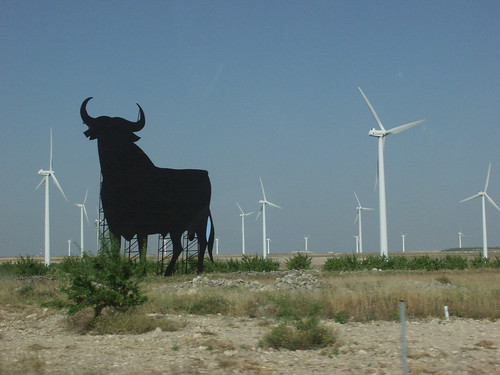Spain’s variable wind and stable electricity networks
Posted by Big Gav in electricity grid, renewable energy, smart grids, spain, wind power
Carbon Commentary has an excellent article on how renewables can provide large amounts of electricity into an electrical grid - in this case Spain's - (Spain’s variable wind and stable electricity networks. Yet if you listened to some people spouting PR for the nuclear power industry, you'd believe this is impossible.
One of the frequent criticisms of wind energy is that national distribution systems (‘the grid’) cannot cope with large number of turbines because of the variability and unpredictability of their output. Grids need to match supply and demand precisely, the critics say, and because wind varies so much it causes huge problems. Recent data from two meteorologically unusual days in Spain – the world leader in the management of renewable energy supplies – shows this assertion is almost certainly false.
* During part of 8 November, Spain saw over 50% of its electricity come from turbines as an Atlantic depression swept over the country’s wind parks. (They are so big that no one seems to call them ‘farms’.) Unlike similar times in November 2008, when Spanish turbines were disconnected because the grid had an excess of electricity, the system accepted and used all the wind power that was offered to it.
* A very different event in January of this year saw unexpectedly high winds shut down most of the country’s turbines with little warning. The grid coped with this untoward incident as well. These two events show that a well run transmission system can cope with extreme and unexpected events even with a large fraction of power provided by wind.
Over the course of this year Spain will generate about 14% of its total electricity from wind and this number is likely to rise to the high twenties by 2020. Spain is showing the rest of the world that these figures are not incompatible with grid stability. Although wind is ‘variable’, ‘intermittent’ and ‘unpredictable’, a well functioning grid system can still use wind to help stabilise electricity costs, reduce carbon emissions and improve energy security.
At some periods on the night of 8/9 November, wind provided 53% of Spain’s need for electricity. This was a new record for the Spanish system. As the country continues to install thousands of new wind turbines a year, this record will not stand for long.
Although Denmark has had similar percentages of its electricity provided by wind, the Spanish numbers are particularly significant. As its electricity transmission company, Red Eléctrica de España or REE, reminds us, the country is unusually isolated from international interconnections. It is ‘a peninsula electrically speaking, with weak electrical interconnections with the European Union’.[1] A country with limited capacity to import or export power has more issues accommodating large amounts of wind power. Denmark has international connections to cover 50% of its electricity while Spain has less than a tenth this amount. (The UK also scores extremely poorly on this dimension.)
Spain is able to manage the integration of wind power into its grid primarily because it has reasonable amounts of hydro-electricity and pumped storage.[2] Hydro-electricity can be used when winds are less than expected and pumped storage can assist both when wind is unexpectedly high or unexpectedly low.
One of the main criticisms levelled at wind is that its power is so unpredictable that huge amounts of fossil fuel generating capacity needs to be kept ready to replace it at a moment’s notice. Those antagonistic to wind believe that the carbon cost of keeping power stations in a state of what the industry calls ‘spinning reserve’ is enormous. Power stations, they say, are burning fuel so that they can instantaneously start producing electricity if and when the wind drops.
But is wind so variable that power stations need to provide immediate backup? The utterly superb REE website provides easy-to-use data to test this theory. I’ve used this data to try to demonstrate that wind production was remarkably consistent during the peak day of 8 November.[3] Not only is wind speed largely predictable with good meteorology, but REE data shows that even in the windy days of early November, the amount of electricity generated only varied gradually.
During this 24-hour period the total generated varied from about 9.3 gigawatts (9,300 megawatts) at the start, to a peak of around 11.5 gigawatts at about 14.30 in the afternoon. For most of the day, the wind output was very stable around 10 gigawatts. (The wind output estimate is provided every ten minutes on the REE website.) The mean percentage variation from one reading to the next was 0.72%. On only three occasions out of 143 observations did the output vary more than 2% between two readings.
When the wind is blowing strongly, any local variations in wind speeds tend to be balanced out by compensating changes elsewhere. A country like Spain, with over ten thousand turbines spread across a large landmass, will have low variability of electricity output from wind. As a country adds wind turbines, the degree of variability in electricity output will tend to fall. In Spain, the variations on 8/9 November represented no threat to the stability of the electricity system, even when wind was meeting half of total power demand.






